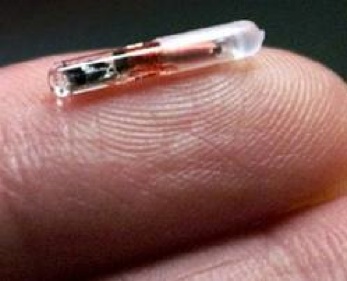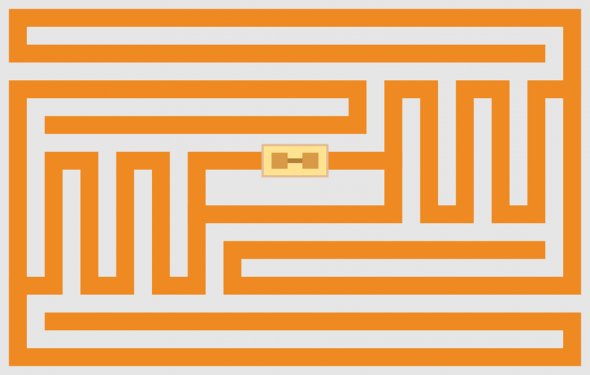What the RFID is That?
In his contribution to this issue’s series of articles linking logistics, workplace surveillance and national security, Brian Ashton zooms in on the microscopic technologies surveilling and shaping working lives detractors and defenders
You already have zero privacy. Get over it.
– Scott McNally, Chief Executive of Sun Microsystems1
On 13 November, 1964, the acting chief constable of Liverpool announced the formation of a commando force of ‘just over 100 specially selected men and women from the city police force who would mix in disguise with the general public.’2 They would work in conjunction with television cameras that were ‘scanning the streets and transmitting pictures to a monitor in headquarters. Any suspicious behaviour would be passed on by radio to the commandos for quick action.’3 The two-way radios were the first to be issued to a British police force. And the use of cameras was watched with interest by police forces around the country. Of course they sometimes got it wrong:
Disguises were so successful at first that more than once, one team of commandos spent more than 45 minutes watching another team, whom they thought were acting suspiciously, and only found out their real identity when they tried to move them on.4
The powerful have always spied on us. They do it to exploit us, to control us, and because they fear us.
With the advent of the modern industrial group in large factories in urban areas, the whole process of control underwent a fundamental revolution. It was now the owner or manager of a factory […] The employer as he came to be called, who had to secure, or exact, from his employees a level of obedience and/or co-operation which would enable him to exercise control.5
In order to do this, the boss man had to employ large numbers of supervisors and company spies, and the spies didn’t confine themselves just to the workplace. During the early days of the Ford Motor Company, the Five Dollar Day period, the company’s sociological department investigated the social lives of the workers, using 30 investigators to check that the workers were living moral lives. If it was found that the money was ‘more of a menace than a benefit to him’, that a worker had ‘developed weaknesses’, his bonuses would be lost for a period of six months. And, if that didn’t bring him to his senses, he was sacked.6 It was, perhaps, an early if crude attempt to connect mentally and emotionally with the workers – like being called in for your monthly assessment. Ford also employed 3,500 security men, whose jobs involved spying on the workers and, if necessary, physically intimidating them, usually by smashing them over the head with a baton. But in the end it was the Fordist mode of production that got beaten over the head with a working class baton. Some 70-odd years after the founding of the Ford Motor Company, the death knell for Fordist methods was sounded by Gianni Angelli, patriarch of the Fiat organisation, when he described Turin’s Mirafiori factory as ‘the ungovernable factory’.

Image: Ford Motor Company security guards attack UAW union organisers, Detroit 1937
The defeat of the Fordist mode of production did not mean the death of scientific management, a system that had its genesis in the work of Andrew Ure and Charles Babbage, and whose most famous practioner was Frederick Winslow Taylor. Scientific management:
is an attempt to apply the methods of science to the increasingly complex problems of the control of labor in rapidly growing capitalist enterprises. It lacks the characteristics of a true science because its assumptions reflect nothing more than the outlook of the capitalist with regards to the conditions of employment […] It does not attempt to discover and confront the cause of this condition, but accepts it as an inexorable given, a ‘natural’ condition. It investigates not labor in general, but the adaptation of labor to the needs of capital.7
Scientific management takes technology as a given – and in this period it should be taken as a given that scientific management is an integral part of the technology that confronts us in our daily life. This article is an attempt to look at how capital tries to use technology to control us 24/7.

Image: Frank B. Gilbreth, Time Motion Study, circa 1914
Along the continuous supply chains of 21st century capitalism reside technological apparatuses that have the capacity to gather information on you. You are policed in ways you may not be aware of; your work uniform could be telling tales on you this very minute, and, if you are using your work computer to read this article on the Mute website, it may well be filming you doing so. Back to work, pal, now. And if you’re tardy in responding to that order, your tardiness could well be recorded by that clock, up there on the wall. Because not only does it go ‘tick tock’, it also films you and records your conversations. And can do so for up to 21 days.
Spying on workers is big business; the net abounds with companies producing and selling the tools to spy on you and keep you in line. The use of workplace technologies by workers for their own benefit is widespread and forces capital to seek the means to curtail it. One company, Spectorsoft, sells a piece of software called Spector CNE Investigator – an employee investigation system. One of the case studies used to advertise the product explains how an electrical utility company used the system to control the use of its computer networks. It quotes the utility company’s information security officer:
Every company will have a need to investigate inappropriate behaviour from time to time. Spector CNE is the complete tool to obtain the needed information. If we ever have to go to court, CNE’s screen snapshots are irrefutable […] Finding and weeding out a problem employee early, that really saves the company money […] Now I know EXACTLY what an individual is doing. I get to see it like a videotape.8
The company mentioned here is based in California, but such software is available globally. Last year in Liverpool, three workers in a benefits office were sacked for inappropriate use of computers. Imagine such action being carried out across the entire Benefits Agency; it could save a lot of money from being paid out in redundancy packages. The companies that produce and sell surveillance equipment also make commodities that can stop such equipment working. Isn’t capitalism wonderful?

Image: Director of Deutsche Bahn, Hartmut Mehdorn, resigns 2009
Spying on workers is widespread and, in some cases, impacts on thousands of people. In 2009 numerous high profile companies in Germany were found to be spying on their workers.9 An employee at Deutsche Telekom had his mobile phone records checked by the company during an investigation into a leak of information to the media. The man was a union representative. On a much larger scale, the rail company Deutsche Bahn owned up to spying on its workforce. Their activity included the monitoring of emails, checking on how many toilet breaks were being taken by individuals, and prying in to the love lives of workers. In 2002-2003, 173,000 workers were screened; in 2005 the entire workforce of 220,000 was spied on.10 The head of Deutsche Bahn, Hartmut Mehdorn, was forced to resign over the issue. Perhaps they got the idea from the retail industry, because in 2008 two discount companies, Lidl and Schlecker, were exposed in the mainstream media for widespread spying. The German weekly, Stern, said it had obtained hundreds of Stasi-like logbooks that minutely monitored the movements and private conversations of employees.
What is happening now is that different aspects of technology are being linked up to produce overarching systems of surveillance. Global Positioning Systems (GPS) and Radio Frequency Identification tags (RFID) are being used to spy on workers in and out of the workplace. GPS relies on satellites orbiting hundreds of miles above the earth. A GPS unit is fitted to a vehicle; this unit can correspond with a satellite and enable the tracking of the vehicle and its driver. In the USA for example there have been instances where GPS technology has been used to monitor workers involved in union recruiting campaigns. In one case, the only two company vehicles fitted with the equipment were the ones used by two workers believed to be organising such a campaign. The National Labour Relations Board (NLRB) recognised that GPS technology would allow the company to interfere with its employees’ protected concerted activity by tracking the two worker-organisers’ every move in real time to immediately detect, for example, if they met at the same location or visited other employees at their homes during non-work hours.11 An RFID consists of a microchip and an antenna and is activated by radio waves transmitted by a reader/scanner. Some tags have minute batteries attached and can self-activate. Although GPS and RFID are technologically different, they share some common abilities. Both can track the locations of individuals, company vehicles and cargos in real time, creating electronic logs relating to location and movement, which can be used to generate detailed reports that could be used to discipline or sack workers. Both systems are out of sight, making them easy to forget – and we do forget. How many people remember the construction of the world’s largest road and vehicle surveillance system? The system that was put in place in Britain over a five-year period starting in 1999 resulted in the installation of thousands of number plate recognition cameras. Cameras that can communicate with the Police National Computer in real time through microwave links and the telephone system.12
Spy cameras are now ubiquitous; they are an integral part of the modern architectural landscape. But don’t worry, they are there for your protection. Honest.

Image: Verichip RFID chip designed for human insertion
RFID is the technology that has the potential to be the most pervasive. It can be put anywhere, and that includes inside you. How does it work? They inject it in to your arm. This is the technical bit. It is a simple construction that consists of a coil of wire and a microchip, hermetically sealed inside of a glass capsule. These devices are 11 millimetres long and about one millimetre in diameter, comparable to a grain of rice. The coil acts as an antenna and uses an RFID reader/scanner’s varying magnetic field to power the microchip and transmit a radio signal. The chip modulates the amplitude of the current going through the antenna to continuously repeat a 128-bit signal. Each chip has a unique identifying number that links to a database. A cap made from special plastic covers half the capsule. The plastic is designed to bond with human tissue and stop the capsule from touring around your innards once it has been implanted. Oh yeah! If you have one of these inside of you and leave the company that had it implanted, then you will have to have an operation to remove it. An American security company that injected the tags into some of its workers went bust. That raises the question of who will pay to have the tag removed.
The tagging of human beings is on the increase. The proponents of tagging point to the perceived benefits of the technology; it can hold or link to information about the identity, physiology, health, nationality and security clearance of the person who carries the embedded chip. According to an American company, VeriChip Corp, a subsidiary of Applied Digital Solutions, as of 2007, 2000 people have had chips implanted. The go-ahead for the tagging of human beings for medical reasons was given by the US Food and Drug Administration in 2004. In 2008 there was some discussion within the British Government about the possibility of implanting chips into prisoners. Following protests from Liberty, the idea seems to have been dropped. In the States the external tagging of prisoners is fairly widespread. It enables prison authorities to know the location of a prisoner 24/7. And in 2004 the Attorney General of Mexico and 18 of his staff had chips implanted to gain access to high security areas. If you are a gambler there are casinos and nightclubs that will chip you; the facility is on offer in Holland, Scotland, Spain and the good old US of A. By the time you get to the bar they’ll have your favourite drink ready for you. VeriChip is pushing the technology to the American State machine; it is proposing a scheme for the tagging of military personnel as an alternative to metal dog tags. And its CEO, Scott Silverman, has proposed the chipping of guest workers entering the United States to assist the government in identifying them. Shortly afterwards, Associated Press quoted President Alvaro Uribe of Columbia as telling a US senator that he would agree to require Columbian citizens to be implanted with RFID tags before they could gain entry into the United States for seasonal work.13 And what of the workers who would have to face the prospect of being chipped? Would they have a choice, or would that old slave-driver poverty take choice away from them? And who would pay for the implanting?

Image: Verichip advertisment
RFID tags being implanted into people is the eye-catching use of the technology, but there are less obvious applications being used to track us. As I mentioned above, your work uniform may be spying on you. The process involves the weaving of metallic fibres into work clothes so that your jacket becomes the tag. They can also put tags into work boots. That plastic ID card you have hanging from a lariat around your neck may have more uses than just telling people who you are. The same goes for the swipe card that allows you access to your workplace. Both items could be carrying information about you that could be linked to various databases; it could contain your National Insurance number, your timekeeping record, your disciplinary record and union affiliation. The latter could certainly be possible in workplaces where the company deducts union dues from the wage packet. They can be used to track your movements around a workplace, thereby policing any union activity you might be undertaking. And if information is taken off your card you could find yourself locked out of the workplace. A few years back, when Ford sold the Halewood car plant to the Indian company, Tata, a dozen workers were locked out on the first day of work under the new owners. Their swipe cards wouldn’t let them gain entry through the turnstiles. It is reckoned that they were identified as activists during the takeover negotiations between the two companies, and were thus surplus to requirements.
Computer monitoring, telephone management systems, hidden cameras and intelligent ID badges plus GPS and RFID are means to spy on us and keep us in line, but they are not the only means of surveillance used. A formidable array of other methods are also employed to gather information about us. They include: drug tests, background checks, intelligence tests, medical examinations and psychological tests (sometimes called psychometric testing). Companies will also visit sites like Facebook to try and discover what you are really like, as opposed to how you sell yourself at a job interview. A psychometric test paper I saw contained the following: 'You are working as a supervisor in a sheltered housing project and you discover that one of the residents is selling drugs. What do you do? A. Ignore it. B. Report it to your supervisor. C. Have a word with the person involved. D. Inform the police.' Well, folks, you are out of work and you want this job, so what box would you tick?
The ‘War on Terror’ has been used as the reason to increase the surveillance of the general population. Terrorists live and work in the communities they are prepared to attack, ergo, spy on the communities. The state’s capacities for surveillance have been increased by the use of such systems as Echelon, a secretive project involving the intelligence agencies of the United States and other governments. Echelon monitors the global electronic spectrum, including telephone, email and satellite communications.14 For the state, security overrides everything, so everything can be made subject to state surveillance – as those who participated in the riots during August will find out when their phone records are handed over to the ‘Feds’.
As I’m finishing this article, the BBC news is telling me that over a hundred people have been arrested in Liverpool for involvement in the riots. Figures for London, Birmingham and Manchester are much higher. Surveillance cameras, phone records and photos from people’s mobile phones have been used to gather the evidence for prosecution. And those prosecutions are being rushed through with indecent haste. As the welfare state model of social control is being dismantled, the need for other forms of control increases. The hegemonic structures are there to encourage us to interiorise the control mechanisms – the prison, the factory, the asylum and the school, for example. As sketched out in this article, capital and the state are using technologies like GPS and RFID to back up the already existing mechanisms of control.
The ‘police’ appears as an administration heading the state, together with the judiciary, the army, and the exchequer. True. Yet in fact, it embraces everything else. Turquet says so: ‘It branches out into all of the people’s conditions, everything they do or undertake. Its field comprises the judiciary, finance, and the army.’ The police includes everything.15
We have to resist the internal and external policing of our lives.
Brian Ashton <brian.ashton00@gmail.com> is an ex car-industry shop steward who developed an interest in the logistics industry while doing support work with the sacked Liverpool dockers in the mid-’90s. He is currently researching the global supply chains of the clothing industry
Footnotes
1 J. Markoff, ‘Growing Compatibility Issues: Computers and User Privacy’, New York Times, 3 March, 1999.
2 Anarchy, Vol. 7 No. 6, June, 1967.
3 Ibid.
4 Ibid.
5 Lyndall Urwick and E.F.L. Brech, The Making of Scientific Management, Vol.2, London, 1957, pp.10-11 quoted in Harry Braverman, Labor and Monopoly Capital, New York: Monthly Review Press, 1974, p.68.
6 Huw Beynon, Working for Ford, Allen Lane, London, Penguin Education, 1975, pp.22-23.
7 Braverman, op. cit. p.86.
8 Spector CNE, Case Studies, http://www.spectorcne.com/casestudies.html
9 See: David Crossland, ‘German Anti-Snooping Law 'Long Overdue”’, Der Speigel, 17 February 2011, http://www.spiegel.de/international/germany/0,1518...
10 Henry Chu, ‘In Germany, widespread spying is back, this time by corporations’, Los Angeles Times, May 23, 2009.
11 NLRB, Office of the General Counsel, Advice Memorandum, 26 February, 2003.
12 And it’s still going on. See Angus Batey, ‘Welcome to Royston … you’re under surveillance’, The Guardian, 29 July, 2011.
13 Kenneth R. Foster and Jan Jaeger, ‘The murky ethics of implanted chips’, http://spectrum.ieee.org/computing/hardware/rfid-i..., March 2007.
14 Michael Hardt and Antonio Negri, Multitude, London: Penguin Books, 2006, pp.202-203.
15 Michel Foucault, ‘“Omnes et Singulatim”: Toward a Critique of Political Reason’, in Power, J.D. Faubion (Ed.), New York: New Press, 2000, pp.318-319.
Mute Books Orders
For Mute Books distribution contact Anagram Books
contact@anagrambooks.com
For online purchases visit anagrambooks.com








